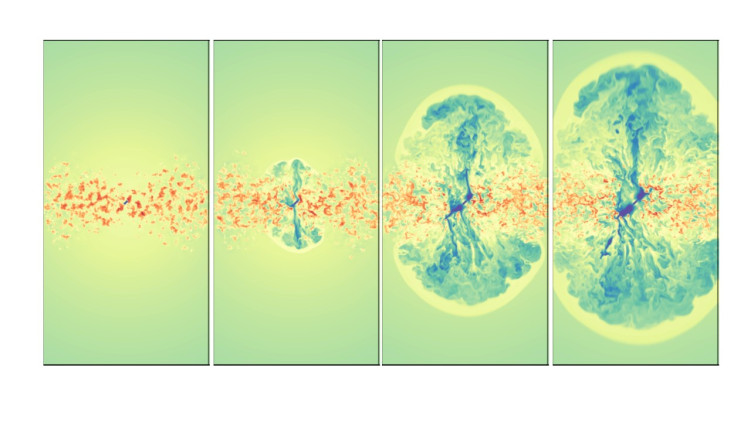Until now, astronomers have always assumed that only black holes with strong radiation stop star formation from within the galaxy. This is because these black holes blow away gas, which is the building block for stars. The question , however, is whether galaxies without strongly radiating black holes are also inhibited in their growth.
Radio emitter
Now, astronomers have discovered a less powerful black hole that also seems to be cleaning up its surroundings. This low-power black hole is found in the galaxy B2 0258+35 in the constellation of Perseus. It does not emit strong radiation but has radio plasma jets that are bright, as opposed to black holes that emit visible light, ultraviolet or X-rays.
The gas at B2 0258+35 is blown away steadily at a speed of about 500 kilometres per second. It is roughly five to ten solar masses per year and takes a few million years. The gas is not moving fast enough to escape from the reach of the galaxy. It eventually falls back and ends up at the edges of the galaxy. From there, it cannot properly form new stars.
Growth inhibitor
"That low-power radio jets have also been found to clean a galaxy is extraordinary," says principal investigator Suma Murthy (working at ASTRON and at the Kapteyn Institute of the University of Groningen during the research). "A large part of the radio emitters are relatively quiet. It was thought that they did not play an important role in growth inhibition. Our results show that these relatively weak radio-emitters can indeed inhibit growth. From now on, we will have to take this into account in models for the evolution of galaxies."
The researchers made their observations in October and November 2020 with the NOEMA telescopes. NOEMA stands for Northern Extended Millimetre Array. It is a collection of radio dishes in the French Alps at an altitude of about 2500 metres. The observations by Murthy and her colleagues had previously been predicted by computer simulations.
Murthy defended her PhD thesis at the University of Groningen on 8 February. She now works as a postdoc at JIVE, the European institute in Dwingeloo that, among other things, coordinates the cooperation of radio telescopes all over the world.
Scientific paper
Cold gas removal from the centre of a galaxy by a low-luminosity jet. By: Suma Murthy (1,2,3), Raffaella Morganti (2,1) Alexander Y. Wagner (4), Tom Oosterloo (2,1) Pierre Guillard (5,6), Dipanjan Mukherjee (7) & Geoffrey Bicknell (8). Accepted for publication in Nature Astronomy. [origineel | preprint (pdf)]
1. Kapteyn Astronomical Institute, University of Groningen, the Netherlands
2. ASTRON, Netherlands Institute for Radio Astronomy, Dwingeloo, the Netherlands
3. Joint Institute for VLBI ERIC, Dwingeloo, the Netherlands
4. Center for Computational Sciences, University of Tsukuba, Ibariki, Japan
5. Institut d’Astrophysique de Paris, Sorbonne Université, CNRS, Paris, France
6. Institut Universitaire de France, Ministère de l’Enseignement Supérieur et de la Recherche, Paris, France
7. Inter-University Centre for Astronomy and Astrophysics, Pune, India
8. Australian National University, Research School of Astronomy and Astrophysics, Weston, Australia
 Four-step simulation of a black hole with a low energy radio jet that clears the centre of a galaxy like a leaf blower. There are 200,000 years between each image. (c) Mukherjee et al. [Watch the animated gif.]
Four-step simulation of a black hole with a low energy radio jet that clears the centre of a galaxy like a leaf blower. There are 200,000 years between each image. (c) Mukherjee et al. [Watch the animated gif.]
